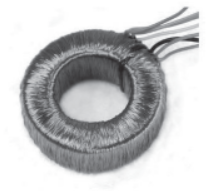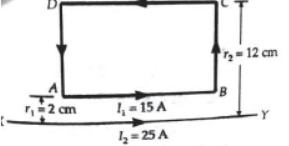Please refer to Moving Charges and Magnetism MCQ Questions Class 12 Physics below. These MCQ questions for Class 12 Physics with answers have been designed as per the latest NCERT, CBSE books, and syllabus issued for the current academic year. These objective questions for Moving Charges and Magnetism will help you to prepare for the exams and get more marks.
Moving Charges and Magnetism MCQ Questions Class 12 Physics
Please see solved MCQ Questions for Moving Charges and Magnetism in Class 12 Physics. All questions and answers have been prepared by expert faculty of standard 12 based on the latest examination guidelines.
MCQ Questions Class 12 Physics Moving Charges and Magnetism
Question. Two identical current carrying coaxial loops, carry current I in opposite sense. A simple amperian loop passes through both of them once. Calling the loop as C, then which statement is correct?

(c) there may be a point on C where B and dl are parallel.
(d) none of these
Answer
B
Question. The correct plot of the magnitude of magnetic field B→ vs distance r from centre of the wire is, if the radius of wire is R

Answer
B
Question. The nature of parallel and anti-parallel currents are
(a) parallel currents repel and anti-parallel currents attract.
(b) parallel currents attract and anti-parallel currents repel.
(c) both currents attract.
(d) both currents repel.
Answer
B
Question. The magnetic moment of a current I carrying circular coil of radius r and number of turns N varies as
(a) 1/r2
(b) 1/r
(c) r
(d) r2
Answer
D
Question. When a magnetic compass needle is carried nearby to a straight wire carrying current, then
(I) the straight wire cause a noticeable deflection in the compass needle.
(II) the alignment of the needle is tangential to an imaginary circle with straight wire as its centre and has a plane perpendicular to the wire.
(a) (I) is correct
(b) (II) is correct
(c) both (I) and (II) are correct
(d) neither (I) nor (II) is correct
Answer
C
Question. Two a-particles have the ratio of their velocities as 3 : 2 on entering the field. If they move in different circular paths, then the ratio of the radii of their paths is
(a) 2 : 3
(b) 3 : 2
(c) 9 : 4
(d) 4 : 9
Answer
B
Question. A charged particle is moving in a cyclotron, what effect on the radius of path of this charged particle will occur when the frequency of the ratio frequency field is doubled?
(a) It will also be doubled.
(b) It will be halved.
(c) It will be increased by four times.
(d) It will remain unchanged.
Answer
D
Question. Which of the following is not correct about cyclotron?
(a) It is a machine to accelerate charged particles or ions to high energies.
(b) Cyclotron uses both electric and magnetic fields in combination to increase the energy of charged particles.
(c) The operation of the cyclotron is based on the fact that the time for one revolution of an ion is independent of its speed or radius of its orbit.
(d) The charged particles and ions in cyclotron can move on any arbitrary path.
Answer
D
Question. A strong magnetic field is applied on a stationary electron. Then the electron
(a) moves in the direction of the field.
(b) remained stationary.
(c) moves perpendicular to the direction of the field.
(d) moves opposite to the direction of the field.
Answer
B
Question. In an inertial frame of reference, the magnetic force on a moving charged particle is F→ . Its value in another inertial frame of reference will be
(a) remained same
(b) changed due to change in the amount of charge
(c) changed due to change in velocity of charged particle
(d) changed due to change in field direction
Answer
C
Question. Which one of the following is correct statement about magnetic forces?
(a) Magnetic forces always obey Newton’s third law.
(b) Magnetic forces do not obey Newton’s third law.
(c) For very high current, magnetic forces obey Newton’s third law.
(d) Inside low magnetic field, magnetic forces obey Newton’s third law.
Answer
B
Question. A charged particle is moving on circular path with velocity v in a uniform magnetic field B, if the velocity of the charged particle is doubled and strength of magnetic field is halved, then radius becomes
(a) 8 times
(b) 4 times
(c) 2 times
(d) 16 times
Answer
B
Question. If an electron is moving with velocity v→ produces a magnetic field B→ , then
(a) the direction of field B→ will be same as the direction of velocity v→
(b) the direction of field B→ will be opposite to the direction of velocity v→
(c) the direction of field B→ will be perpendicular to the direction of velocity v→
(d) the direction of field B→ does not depend upon the direction of velocity v→
Answer
C
Question. Current flows through uniform, square frames as shown in the figure. In which case is the magnetic field at the centre of the frame not zero?

Answer
C
Question. Ampere’s circuital law is given by

Answer
B
Question. A short bar magnet has a magnetic moment of 0.65 J T–1, then the magnitude and direction of the magnetic field produced by the magnet at a distance 8 cm from the centre of magnet on the axis is
(a) 2.5 × 10–4 T, along NS direction
(b) 2.5 × 10–4 T, along SN direction
(c) 4.5 × 10–4 T, along NS direction
(d) 4.5 × 10–4 T, along SN direction
Answer
B
Question. A current carrying loop is placed in a uniform magnetic field. The torque acting on it does not depend upon
(a) area of loop
(b) value of current
(c) magnetic field
(d) None of these
Answer
D
Question. In a moving coil galvanometer the deflection (Φ) on the scale by a pointer attached to the spring is

Answer
C
Question. A moving coil galvanometer can be converted into an ammeter by
(a) introducing a shunt resistance of large value in series.
(b) introducing a shunt resistance of small value in parallel.
(c) introducing a resistance of small value in series.
(d) introducing a resistance of large value in parallel.
Answer
B
Question. In definition of 1 A, the force between two very long, straight, parallel conductors of negligible cross-section, placed 1 m apart in vacuum is
(a) 2 X 10-7 N
(b) 0.2 X 10 N
(c) 20 X 10 N
(d) None of the above
Answer
D
Question. The magnetic field in the outside region of the given figure is :

(a) μ0nI
(b) μ0NI
(c) infinite
(d) zero
Answer
D
Question. Which of the following is an incorrect formula for magnetic force experienced by a conductor in magnetic field? Options are not readable due to notation
(a) I (LXB)
(b) (jAL) X B
(c) nALqvd X B
(d) I (jL X B)
Answer
D
Question. When a rectangular coil carrying current is suspended in magnetic field, then net force experienced by the coil is:
(a) nIBAsinφ
(b) M X B
(c) zero
(d) nIBA
Answer
C
Question. A horizontal overhead power line carries a current of 90 A in east to west direction. What are the magnitude and direction of the magnetic field due to this current 1.5 m below the line?
(a) 1.2 x 10-5T perpendicularly outwards to the plane of paper
(b) 1.9 x 10-5T perpendicularly outwards to the plane of paper
(c) 2.6x 10-5T perpendicularly inwards to the plane of paper
(d) 2.6 x 10-5T perpendicularly outwards to the plane of paper
Answer
A
Question. Calculate the force experienced by the loop in the given figure:

(a) 17.8 X 10-4 N (Attractive)
(b)7.8 X 10-4 N (Attractive)
(c) 17.8 X 10-6 N (Attractive)
(d) 7.8 X 10-4 N (Repulsive)
Answer
B
Question. A galvanometer cannot be used as such as an ammeter because
(a) it has low resistance
(b) it has low sensitivity
(c) it has high resistance
(d) it is not well calibrated always.
Answer
C
Question. Just as static charges produce electric field, moving charges produce:
(a) Electric field only
(b) magnetic field only
(c) Both electric and magnetic fields
(d) drift velocity
Answer
C
Question. ‘Parallel current CARRYING WIRES__________ and antiparallel current CARRYING WIRES ____________.
(a) attract, repel
(b) repel,attract
(c) attract, attract
(d) repel,repel
Answer
A
Question. According to Biot Savart’s law, the magnetic field produced by a current carrying conductor is perpendicular to the plane containing:
(a) r
(b) Idl
(c) the conductor
(d) r and Idl
Answer
D
Question. If the force per unit length between two long straight wires carrying currents 4 A and 6 A is 1.6 X 10-4 N/m, then the distance between the wires is
(a) 5 cm
(b) 3 cm
(c) 3 m
(d) 1 cm
Answer
B
Question. If magnetic field inside a solenoid is 15 T, then what will be the approximate magnetic field near its one end?
(a) 30 T
(b) 7.5 T
(c) 15 T
(d) 0
Answer
B
Question. As per Ampere’s circuital law, the magnetic field at every point on a circle of radius r, HAVING current carrying wire along the axis, possesses ____________symmetry.
(a) spherical
(b) Linear
(c) cylindrical
(d) none of these
Answer
C
Question. The magnetic force acting on a charged particle having charge -3μC in a magnetic field of 2 T acting in y direction, when the particle velocity is (2𝑖̂ + 3𝑗̂) X 106 m/s is
(a) 12 N in -z direction
(b) 12 N in y direction
(c) 12 N in z direction
(d) 18 N in -z direction.
Answer
A
Question. A galvanometer having a resistance of 9Ω is shunted by a wire of resistance 2 Ω. If the total current is 1A, the part of it passing through the shunt will be
(a) 0.2 A
(b) 0.8 A
(c) 0.25 A
(d) 0.5 A
Answer
B
Question. The value of gyromagnetic ratio, μ/𝑙 = 𝑒/2𝑚’ for an electron is:
(a) 6.6 X 10-34 C/kg
(b) 8.8 X 1010 C/Kg
(c) 8.85 X 1012 C/kg
(d) 1.6 X 10-19 C/kg
Answer
B
Question. If a straight current carrying wire is suspended horizontally in mid-air by a uniform magnetic field, then what could be the possible reason for it?
(a) The gravitational force is balanced by electric field produced by wire.
(b) The external magnetic field is balanced by magnetic field due to conductor.
(c) The magnetic field produced by conductor is balanced by magnetic field of Earth.
(d) The gravitational force on the conductor is balanced by external magnetic field.
Answer
D
Question. The conversion of a moving coil galvanometer into a voltmeter is done by
(a) introducing a resistance of large value in series.
(b) introducing a resistance of small value in parallel.
(c) introducing a resistance of large value in parallel.
(d) introducing a resistance of small value in series.
Answer
A
Assertion and Reasoning Based Questions :
(a) Both A and R are true and R is the correct explanation of A.
(b) Both A and R are true and R is not the correct explanation of A.
(c) A is true but R is false.
(d) A is false and R is also false
Question. Assertion: If an electron and proton move in a uniform magnetic field with same speed in perpendicular direction, then they will experience same force (IN MAGNITUDE)
Reason: These particles have same charges.
Answer
C
Question. Assertion: The range of ‘galvanometer converted into an ammeter’ can be increased by reducing the value of shunt.
Reason: Shunt is connected in parallel TO galvanometer.
Answer
A
Read the two statements Assertion (A) and Reason (R) carefully to mark the correct option out of the options given below:
(a) Assertion and Reason both are correct statements and Reason is correct explanation for Assertion.
(b) Assertion and Reason both are correct statements but Reason is not correct explanation for assertion.
(c) Assertion is correct statement but Reason is wrong statement.
(d) Assertion is wrong statement but reason is correct statement.
Question. Assertion: Magnetic field lines can be entirely confined within the core of a toroid, but not within a straight solenoid.
Reason: The magnetic field inside the solenoid is uniform.
Answer
B
Question. Assertion: A spark occurs between the pole of the switch when the switch is opened.
Reason: Current flowing in the conductor produces magnetic field.
Answer
B
Question. Assertion: When a charged particle moves perpendicular to magnetic field then its kinetic energy and momentum gets affected.
Reason: Force changes velocity of charged particle.
Answer
D
Question. Assertion: When two long parallel wires, hanging freely are connected in parallel to a battery, they come closer to each other.
Reason: Wires carrying current in opposite direction repel each other.
Answer
B
Question. Assertion: A solenoid tends to expand, when a current passes through it.
Reason: Two straight parallel metallic wires carrying current in same direction attract each other.
Answer
D
Question. Assertion: When force is zero, the charged particle follows linear path.
Reason: A charged particle enters in a uniform magnetic field, whose velocity makes an angle θ with magnetic field will cover a linear path.
Answer
C
Question. Assertion: An electron and proton enters a magnetic field with equal velocities, then the force experienced by proton will be more than
electron.
Reason: The mass of proton is 1837 times more than the mass of electron.
Answer
D
Question. Assertion: When a magnetic dipole is placed in a non uniform magnetic field, only a torque acts on the dipole.
Reason: Force would act on dipole if magnetic field is uniform.
Answer
D
Question. Assertion: An ammeter is a connected in series in the circuit.
Reason: An ammeter is a high resistance galvanometer.
Answer
C
Question. Assertion: The magnetic field at the centre of circular coil carrying current changes, if the current through the coil is doubled.
Reason: The magnetic field intensity is dependent on current in conductor.
Answer
A



